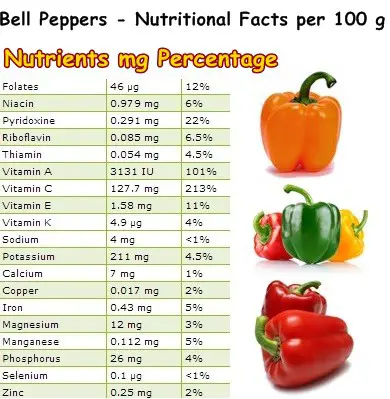Are Bell Peppers Acidic?
Sweet and full of flavor, bell peppers are a delicious as well as nutritious choice for anyone looking to eat and be healthy. The variety is also called sweet pepper or simply pepper in the UK and Canada and capsicum in New Zealand, Australia and certain parts of Southeast Asia. The term capsicum is derived from the name of the species it belongs to, Capsicum Annuum. At the same time, it is a reference to capsaicin, a compound in hot peppers or chili peppers, responsible for their pungent taste and particular benefits.
However, unlike chili and all other pepper varieties, bell peppers lack capsaicin, hence their relatively sweet flavor and alternative name.
But most important, the bell pepper lists a varied and impressive content of essential vitamins which make it rank high as one of the healthiest foods in the world. With a few exceptions, it makes quite a wonderful food to include in you diet as it can help improve and prevent a variety of medical conditions. The bell pepper is actually one of the best sources of vitamin C among fruits and vegetables, as well as a great source of vitamin A and contains good amounts of B vitamins, especially folic acid and pyridoxine.
A good source of dietary fiber, low in calories and high in water, it makes an ideal weight loss food and combats dehydration.
Discover more : Are Bell Peppers Acidic?

What do bell peppers look like?
The variety is best known as bell pepper because of its particular bell-like shape. The culinary vegetable comes in different sizes, including small, weighing around 75 g, medium at around 120 g and large, weighing over 150 g. The four most common varieties of bell pepper are green, red, yellow and orange. Less popular varieties come in other colors such as a cocoa brown, purple and a pale yellow.
Bell peppers have a smooth, thin outer skin that is meaty and crisp underneath. White, spongy ribs with tiny, white seeds stemming from the top of the pepper can be found on the interior and follow the inside ridges of the vegetable halfway. The entire pepper is edible, but the woody stem sometimes left on the bell pepper to prolong shelf life should be discarded.
What do bell peppers taste like?
The alternative name sweet peppers attributed to bell peppers is not entirely accurate as not all varieties of bell peppers taste sweet. The green bell pepper usually has a more bitter, green taste. The red bell pepper is the sweetest, with a moderate sweet flavor and peppery taste. The yellow and orange varieties are somewhere in between, neither bitter, nor particularly sweet, but still a bit of both.
Usually, the longer the pepper is left to ripen on the plant, the sweeter it will be. If harvested prematurely, it will have a more bitter, green taste. If watered sufficiently, the pepper will have a meaty, crisp texture.
What do bell peppers smell like?
Bell peppers should have a pleasant, peppery smell to them. The green variety is usually the one with the most distinct smell.
What do bell peppers go with?
Bell peppers are quite versatile culinary vegetables and can be consumed raw in salads or cooked either alone or in combination with other vegetables and meat. A simple bell pepper salad: wash and dry 1 green bell pepper, 1 red bell pepper and 1 yellow bell pepper, peel one small onion. Slice the peppers thinly, add the finely chopped onion and season with salt, sunflower or olive oil and optionally, pepper.
You can make an all green bell pepper salad for a more bitter -flavored dish or use only red, yellow and orange peppers if you want something sweeter. Bell peppers also go good with radishes and tomatoes, avocado, spinach and green salads.
Bell peppers taste wonderfully roasted and dipped in garlic sauce made from a few crushed garlic cloves, salt and a few tablespoons of water. They also go good with peas, tomato sauce and chicken. One of may favorite recipes is green bell pepper risotto. Cut a 2-3 large green bell peppers in slices, chop one medium-sized yellow onion and fry them in a cup of sunflower oil.
Separately boil chicken legs until they are more than half cooked, add the rice and the bell pepper and onion stir-fry. Cook until the rice is done. Whether it’s one color or half a rainbow, bell peppers will certainly make any dish look more appealing and taste exquisite.

What are the benefits of Bell Peppers?
With a maximum of 31 kcal/100 g, bell peppers contribute to a slimmer waistline and help you maintain a steady weight. Green varieties only have 21 kcal/100 g, making them even more figure-friendly. They are also 93% water and help combat dehydration. Other macronutrients in bell peppers include: around 6 g of carbohydrates, between 2.5 and 4 g of sugar (depending on how sweet the peppers are), less than 1 g of protein and less than 0.3 g of fat as well as 1.7 to 2 g of dietary fiber (content in green vs red and yellow). Dietary fiber is especially good for the digestive system, helping regulate transit time and relieve constipation, with benefits for hemorrhoids.
Although they lack capsaicin, an analgesic, antibacterial and anticarcinogenic compound responsible for the pungent taste of chili peppers, all bell peppers are excellent sources of vitamin C, one of the most potent natural anti-inflammatory and antioxidant nutrients. Depending on variety and growing conditions, bell peppers may contain anywhere from 80 mg of vitamin C in green bell peppers to 127 mg in red and 183.5 mg in yellow ones.
And if you are interested in looking young, then a high intake of vitamin C is the best way of achieving this. Why? Because it is the one substance crucial for the synthesis of collagen, the main structural protein that ensures the integrity of our blood vessels, internal organs, bones and skin. What vitamin C does for skin is help it preserve elasticity, delaying wrinkles. Furthermore, vitamin C has mild pain relieving properties, helping improve headaches and even arthritis joint pain.

In addition to this, regular consumption of foods rich in vitamin C helps prevent scurvy, gum disease and boosts immunity. Moreover, it is scientifically proven that vitamin C is efficient at neutralizing the harmful effects of free radicals and limit their damage to cells and DNA as well as has anticancer properties. Bell peppers contain significant amounts of pro-vitamin A antioxidants in the form of beta-carotene and other carotenoids. Vitamin A from antioxidant carotenoids plays a crucial role in cell growth, is important for skin and mucous membrane health and promotes vision acuity for good eyesight. Red peppers are highest in vitamin A precursor carotenoids, with 157 mcg (3131 IU, international units) of vitamin A per 100 g.
With around 1.58 mg of vitamin E per 100 g (10% of the recommended daily intake), sweet peppers further provide antioxidant benefits to skin and help skin cells better retain moisture for a healthier appearance and better hydration. They are also a good source of B vitamins, particularly folic acid (46 mcg in red peppers, 26 in yellow and 10 in green ones) as well as pyridoxine or vitamin B6 (0.29 mg in red peppers, 0.168 mg in yellow and 0.224 mg in green peppers). This makes them a healthy food for pregnant women thanks to folic acid which supports circulation and helps prevent brain, spine and spinal cord defects in newborns. Vitamin B6 benefits skin and eyes and promotes nervous system health. Bell peppers are a good food for preventing anemia thanks to their folic acid, vitamin B6 and vitamin C content.
The culinary vegetable contains small amounts of almost all essential dietary minerals, particularly iron, manganese, potassium and phosphorus and less than 1% sodium. Dietary mineral are essential for good health, have a tonic action and restore vitality. Bell peppers are actually one of the few plant foods to contain selenium, despite in low amounts (see nutrition table above). Selenium is vital for the production of thyroid hormones, regulating most of what is metabolism. Also see article on the benefits of Chili pepper.
Conclusion
Overall, bell peppers make an excellent choice for any meal and can be successfully introduced in any diet, so long as you don’t experience side effects. Common side effects of eating peppers include acid reflux, heartburn and worsening of gastritis symptoms. If their sweetness does not appeal to you, you can always choose unripe ones which have a slightly bitter taste, but are just as nutritious. Bell peppers make an ideal stew and give risottos an exquisite flavor. They are delicious roasted and make for a refreshing, crisp and sweet tasting summer salad.
